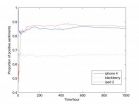(Press-News.org) First on top of the world and then in the depths of despair – this is what the extreme mood changes for people with bipolar disorder are like. Under the direction of scientists from Bonn, Mannheim and Basel, an international collaboration of researchers discovered two new gene regions that are connected to the prevalent disease. In addition, they were able to confirm three additional suspect genes. In this unparalleled worldwide study, the scientists are utilizing unprecedented numbers of patients. The results are now being published in the renowned journal "Nature Communications."
Throughout the course of their lives, about one percent of the population suffers from bipolar disorder, also known as manic-depressive disorder. The patients undergo a veritable rollercoaster of emotions: During extreme shifts, they experience manic phases with delusions of grandeur, increased drive and a decreased need for sleep as well as depressive episodes with a severely depressed mood to the point of suicidal thoughts.
The causes of the disease are not yet fully understood, however, in addition to psychosocial triggers, genetic factors play a large role. "There is no one gene that has a significant effect on the development of bipolar disorder. Many different genes are evidently involved and these genes work together with environmental factors in a complex way," says Prof. Sven Cichon, Director of the Department of Human Genetics at the University Hospital of Basel.
Genetic data from 24,000 people
In recent years, the scientists had already been successful in decoding several genes associated with bipolar disorder. In their search for further genetic risk regions, the researchers working with Prof. Markus M. Nöthen from the University of Bonn Hospital, Prof. Marcella Rietschel from the Central Institute of Mental Health of Mannheim and Prof. Sven Cichon from the University Hospital of Basel are now using unprecedented numbers of patients in an international research collaboration: New genetic data from 2,266 patients with manic-depressive disorder and 5,028 control persons were obtained, merged with existing data sets and analyzed together. In total, data on the genetic material of 9,747 patients were compared with data from 14,278 healthy persons.
The search for genes involved in the manic-depressive disorder is like looking for a needle in a haystack. "The contributions of individual genes are so minor that they normally cannot be identified in the 'background noise' of genetic differences," explains Sven Cichon, Professor for human genetics at the University of Basel. "Only when the DNA from very large numbers of patients with bipolar disorder are compared to the genetic material from an equally large number of healthy persons can differences be confirmed statistically."
Two new gene regions discovered and three known regions confirmed
Using automated analysis methods, the researchers recorded about 2.3 million different regions in the genetic material of patients and comparators, respectively. The subsequent evaluation using biostatistical methods revealed a total of five risk regions on the DNA associated with bipolar disorder. Two of these regions were newly discovered: The gene "ADCY2" on chromosome five and the so-called "MIR2113-POU3F2" region on chromosome six. The risk regions "ANK3", "ODZ4" and "TRANK1" have already been described in prior studies. "These gene regions were, however, statistically better confirmed in our current," says psychiatrist Prof. Marcella Rietschel from the Central Institute of Mental Health of Mannheim.
The researchers are particularly interested in the newly discovered gene region "ADCY2". It codes an enzyme which is involved in the conduction of signals into nerve cells. "This fits very well with observations that the signal transfer in certain regions of the brain is impaired in patients with bipolar disorder," explains the geneticist Prof. Markus Nöthen from Bonn. With their search for genetic regions, the scientists are gradually clarifying the causes of manic-depressive disorder. Their aim is to find starting points for new therapies.
INFORMATION: END
New gene for bipolar disorder discovered
2014-03-11
ELSE PRESS RELEASES FROM THIS DATE:
Dynamic stressing of a global system of faults results in rare seismic silence
2014-03-11
SAN FRANCISCO, March 11, 2014 -- In the global aftershock zone that followed the major April 2012 Indian Ocean earthquake, seismologists noticed an unusual pattern – a dynamic "stress shadow," or period of seismic silence when some faults near failure were temporarily rendered incapable of a large rupture.
The magnitude (M) 8.6 earthquake, a strike-slip event at intraoceanic tectonic plates, caused global seismic rates of M≥4.5 to spike for several days, even at distances tens of thousands of kilometers from the mainshock site. But beginning two weeks after the ...
Timid jumping spider uses ant as bodyguard
2014-03-11
A timid jumping spider uses the scent of ants as a secret weapon to save itself from becoming the somewhat soggy prey of the predatory spitting spider. The downside to this plan is that jumping spiders are also a favorite snack of its very own saviors. To overcome this additional hazard, the spider has made yet another plan in the form of an ant-proof nest, writes Ximena Nelson of the University of Canterbury in New Zealand and Robert Jackson of the University of Canterbury and the International Centre of Insect Physiology and Ecology in Kenya, in Springer's journal Behavioral ...
Magnet hospitals have higher quality of care, NYU researcher finds
2014-03-11
Magnet recognition is considered a leading source for measuring organizational success in nursing. Magnet hospitals show higher job satisfaction and lower odds of patient mortality than non-Magnet hospitals. However, only nine percent of American hospitals are recognized as Magnet. Currently, there is little research into the causes of the differences between Magnet and non-Magnet hospitals, research that could create an infrastructure for positive change in nurse and patient outcomes.
Now research from New York University College of Nursing (NYUCN) and the University ...
Some galaxies in the early universe grew up quickly
2014-03-11
Pasadena, CA— Some galaxies grew up in a hurry. Most of the galaxies that have been observed from the early days of the universe were young and actively forming stars. Now, an international team of astronomers, including Carnegie's Eric Persson and Andy Monson, have discovered galaxies that were already mature and massive in the early days. Fifteen mature galaxies were found at a record-breaking average distance of 12 billion light years, when the universe was just 1.6 billion years old. Their existence at such an early time raises new questions about what forced them to ...
Why antisocial youths are less able to take the perspective of others
2014-03-11
This news release is available in German. Adolescents with antisocial personality disorder inflict serious physical and psychological harm on both themselves and others. However, little is yet known about the underlying neural processes. Researchers at the University of Leiden and the Max Planck Institute for Human Development have pinpointed a possible explanation: Their brain regions responsible for social information processing and impulse control are less developed.
The study focused on incarcerated delinquent adolescents from the Netherlands aged between 15 and ...
How Twitter shapes public opinion
2014-03-11
WASHINGTON D.C., March 11, 2014 -- How exactly does Twitter, with its 241 million users tweeting out 500 million messages daily, shape public opinion?
That question was tackled by a group of researchers in China who investigated how opinions evolve on Twitter by gathering about 6 million 140-character-or-less messages that were tweeted out over a six month period in the first half of 2011. They ran these messages through computer algorithms that sorted them by topic ("iPhone 4" or "blackberry," for instance), and they analyzed the underlying sentiments of the authors ...
Soil microbes shift as shrubs invade remnant hill prairies
2014-03-11
URBANA, Ill. – Perched high on the bluffs of the big river valleys in the Midwest are some of the last remnants of never-farmed prairie grasslands. These patches, edged by forest, are slowly being taken over by shrubs. A recent University of Illinois study examined the soil microbes on nine patches, also called "balds," that had varying degrees of shrub invasion and found an interesting shift in the composition of the microbial community.
"When we looked at the soil samples from a lightly encroached hill prairie remnant, it was very clear that there was a set of fungi ...
Tracking neighborhood eating habits to promote healthier diets
2014-03-11
Poor food choices, such as overconsumption of carbonated soft drinks, are an important factor driving the global obesity epidemic and have been linked directly to diabetes and heart disease. While public health agencies are working to help people to make healthier choices, monitoring the effectiveness of these efforts has been costly and difficult. But now, using the same digital data employed by marketers to promote food products, McGill University's David Buckeridge has developed a way for health agencies to track Montreal consumers' food choices, neighborhood by neighborhood. ...
NASA saw some power in Tropical Cyclone Gillian before making landfall
2014-03-11
VIDEO:
The TRMM Satellite's Precipitation Radar data was used to create this 3-D flyby over Tropical Cyclone Gillian on March 10. Some powerful storms within Gillian reached heights above 16 km/~9.9...
Click here for more information.
NASA's TRMM satellite saw some towering thunderstorms in Tropical Cyclone Gillian before it made landfall over the Western Cape York Peninsula of Queensland, Australia. Gillian has been staying over land since, and is now a remnant low pressure area. ...
Higher levels of CSF alpha-synuclein predict faster cognitive loss in Parkinson disease
2014-03-11
Philadelphia, PA, March 11, 2014 – The course of Parkinson disease (PD) can vary from gradual deterioration to precipitous decline in motor or cognitive function. Therefore identifying predictors of progression can benefit understanding of PD disease progression and impact management. Data from 304 PD patients followed for up to 8 years indicate that patients with higher cerebrospinal fluid (CSF) alpha-synuclein levels experienced faster cognitive decline in the following months, although no associations were found between alpha-synuclein levels and motor changes. The results ...



